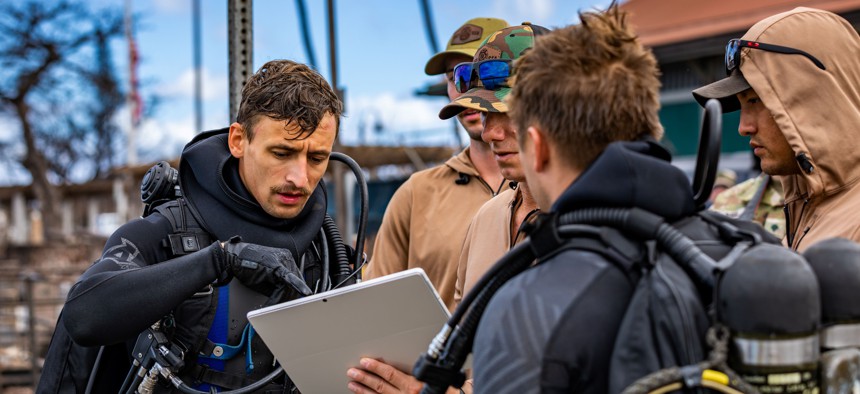
Sailors assigned to Mobile Diving and Salvage Unit One (MDSU-1) discuss search and survey operations in Lahaina Harbor in Maui, Aug. 27, 2023. U.S. Army National Guard / Sgt. Lianne M. Hirano
‘Quite the eerie feeling’: Navy divers complete search for remains in Lahaina Harbor
The Pentagon’s task force is now distributing fuel and potable water in Maui.
HONOLULU, Hawaii—Navy divers have surveyed the bottom of Lahaina Harbor and finished a “very thorough” but non-invasive underwater search for remains in the continuing response to the Maui wildfires.
A team of 21 Pearl Harbor-based divers arrived in Maui last week and immediately began underwater mapping and survey operations at the request of the Maui Fire Department, Senior Chief Jeremy Kilchenstein told Defense One.
Kilchenstein, a master diver with Mobile Diving and Salvage Unit 1, said Maui firefighters had done “a quick sweep of the harbor and determined that the bottom, due to wreckage and debris, was a little more technical that they were aware of at first,” so they asked the Navy divers to help.
The underwater surveys included sonar mapping and video documentation. Petty Officer 2nd Class Sephten Clevenger said the situation in the harbor is very complex, with about 20 partially intact vessels between 10 and 35 feet long, sunk mainly along the edges.
“Getting in the water and first seeing the boats, they’re toppled on top of each other,” Clevenger said, which makes a “thorough and methodical search” more difficult and dangerous. “I know going through a couple of the boats, it’s quite tragic to see what had happened to them.”
The divers did several survey dives, sonar mapping, and video documentation to understand the hazards and provide options before beginning their search, Kilchenstein said.
The team provided manpower support, so Maui authorities could focus on a larger open-water search area, as well as surface-supplied diving equipment, which allows divers to stay underwater for much longer than standard scuba tanks. Because of the difficulty of the work the divers are doing, they would only be able to stay underwater for 30 to 45 minutes using a normal tank, “whereas we can keep our divers in the water for, you know, upwards of three or four hours,” Kilchenstein said.
Though the divers work with the Defense POW-MIA Accounting Agency, or DPAA, for the recovery of missing World War II and Vietnam troops and are trained in the recovery of human remains, they are not trained specifically to identify human remains, Kilchenstein said. Instead, they look for things that are different than the surrounding environment, then turn that over to a DPAA forensic anthropologist for identification.
“We were able to do a pier search just outside of the harbor. I was diving with a partner of mine and I found a cavity underneath the pier. Just thinking something got swept under, I was able to come up on a dog.…You’re looking for something different. It’s only ash and debris and burnt logs down there, and there was just a bright white skull,” Clevenger said. “It’s quite the eerie feeling to just know that you’re looking for something.”
Now that the survey and a thorough search is complete, the team is standing by to provide further help if requested by the state government, Kilchenstein said. “We’ve just covered what we can without moving large pieces of wreckage and debris.”
As of the morning of Aug. 29, 580 National Guardsmen, 133 Defense Department personnel, and 119 Coast Guardsmen were “actively engaged” in the response to the Maui wildfire, a Pentagon spokesperson said. U.S. Army Pacific is doing nine missions in Maui, including mortuary affairs support, fuel distribution, and potable water distribution, Lt. Col. Devin Robinson said.
The U.S. Army 25th Infantry Division’s heavy expanded mobility tactical truck fuelers had distributed roughly 470 gallons of fuel in the previous 48 hours to support U.S. Army Corps of Engineers “temporary power operations,” and Pacific Air Forces delivered two truck fuelers, two water tanks, and six troops for the task force’s water-distribution mission, Robinson said.


